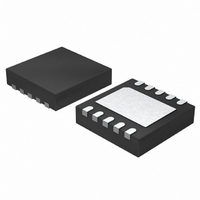LTC3407EDD-3#PBF Linear Technology, LTC3407EDD-3#PBF Datasheet - Page 7

LTC3407EDD-3#PBF
Manufacturer Part Number
LTC3407EDD-3#PBF
Description
IC REG DC/DC DUAL STEPDOWN 10DFN
Manufacturer
Linear Technology
Type
Step-Down (Buck)r
Datasheet
1.LTC3407EDD-3PBF.pdf
(16 pages)
Specifications of LTC3407EDD-3#PBF
Internal Switch(s)
Yes
Synchronous Rectifier
Yes
Number Of Outputs
2
Voltage - Output
0.6 ~ 5 V
Current - Output
1A
Frequency - Switching
1.5MHz
Voltage - Input
2.5 ~ 5.5 V
Operating Temperature
-40°C ~ 85°C
Mounting Type
Surface Mount
Package / Case
10-DFN
Lead Free Status / RoHS Status
Lead free / RoHS Compliant
Power - Output
-
Available stocks
Company
Part Number
Manufacturer
Quantity
Price
OPERATION
The LTC3407-3 uses a constant frequency, current mode
architecture. The operating frequency is set at 2.25MHz
and can be synchronized to an external oscillator. Both
channels share the same clock and run in-phase. To suit
a variety of applications, the selectable Mode pin allows
the user to choose between low noise and light load ef-
fi ciency.
The output voltage is set by an internal divider. An error
amplifi er compares the divided output voltage with a
reference voltage of 0.6V and adjusts the peak inductor
current accordingly. An undervoltage comparator pulls the
POR output low if the output voltage is not above –8.5%
of the reference voltage. The POR output will go high after
262,144 clock cycles of achieving regulation.
Main Control Loop
During normal operation, the top power switch (P-channel
MOSFET) is turned on at the beginning of a clock cycle
when the V
The current fl ows into the inductor and the load increases
until the current limit is reached. The switch turns off and
energy stored in the inductor fl ows through the bottom
switch (N-channel MOSFET) into the load until the next
clock cycle.
The peak inductor current is controlled by the internally
compensated I
ror amplifi er. This amplifi er compares the V
Diagram) to the 0.6V reference. When the load current
increases, the V
reference. This decrease causes the error amplifi er to
increase the I
matches the new load current.
The main control loop is shut down by pulling the RUN
pin to ground.
Low Current Operation
Two modes are available to control the operation of the
LTC3407-3 at low currents. Both modes automatically
switch from continuous operation to the selected mode
when the load current is low.
OUT
TH
TH
voltage is below the the regulated voltage.
voltage until the average inductor current
FB
voltage, which is the output of the er-
voltage decreases slightly below the
FB
(see Block
To optimize effi ciency, the Burst Mode operation can be
selected. When the load is relatively light, the LTC3407-3
automatically switches into Burst Mode operation, in which
the PMOS switch operates intermittently based on load
demand with a fi xed peak inductor current. By running
cycles periodically, the switching losses which are domi-
nated by the gate charge losses of the power MOSFETs
are minimized. The main control loop is interrupted when
the output voltage reaches the desired regulated value. A
voltage comparator trips when I
off the switch and reducing the power. The output capaci-
tor and the inductor supply the power to the load until I
exceeds 0.65V, turning on the switch and the main control
loop which starts another cycle.
For lower ripple noise at low currents, the pulse-skipping
mode can be used. In this mode, the LTC3407-3 continues
to switch at a constant frequency down to very low cur-
rents, where it will begin skipping pulses. The effi ciency in
pulse-skipping mode can be improved slightly by connect-
ing the SW node to the MODE/SYNC input which reduces
the clock frequency by approximately 30%.
Dropout Operation
When the input supply voltage decreases toward the
output voltage, the duty cycle increases to 100% which
is the dropout condition. In dropout, the PMOS switch is
turned on continuously with the output voltage being equal
to the input voltage minus the voltage drops across the
internal P-channel MOSFET and the inductor.
An important design consideration is that the R
of the P-channel switch increases with decreasing input
supply voltage (See Typical Performance Characteristics).
Therefore, the user should calculate the power dissipation
when the LTC3407-3 is used at 100% duty cycle with low
input voltage (See Thermal Considerations in the Applica-
tions Information Section).
Low Supply Operation
To prevent unstable operation, the LTC3407-3 incorporates
an undervoltage lockout circuit which shuts down the part
when the input voltage drops below about 1.65V.
TH
is below 0.65V, shutting
LTC3407-3
DS(ON)
34073fb
7
TH













